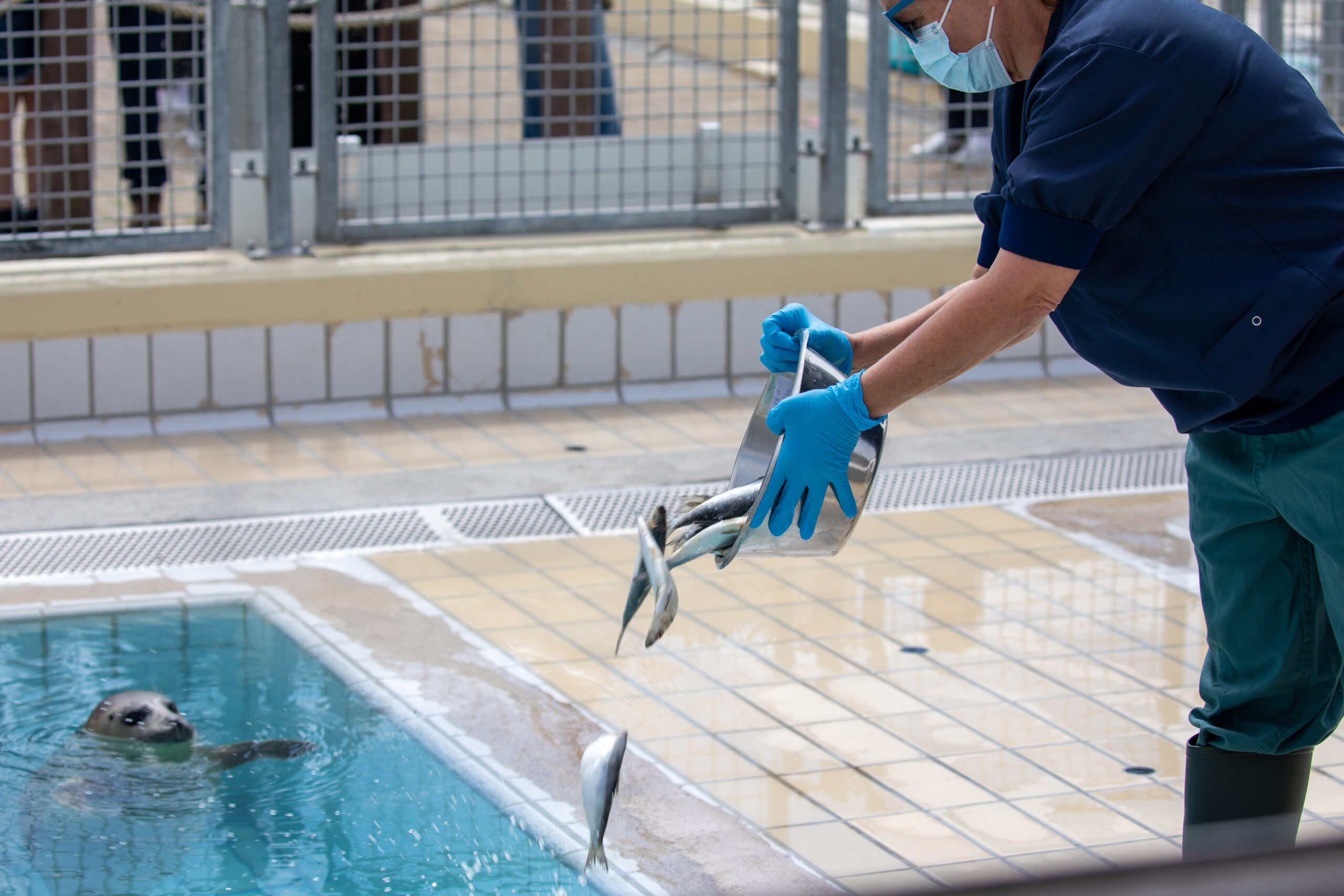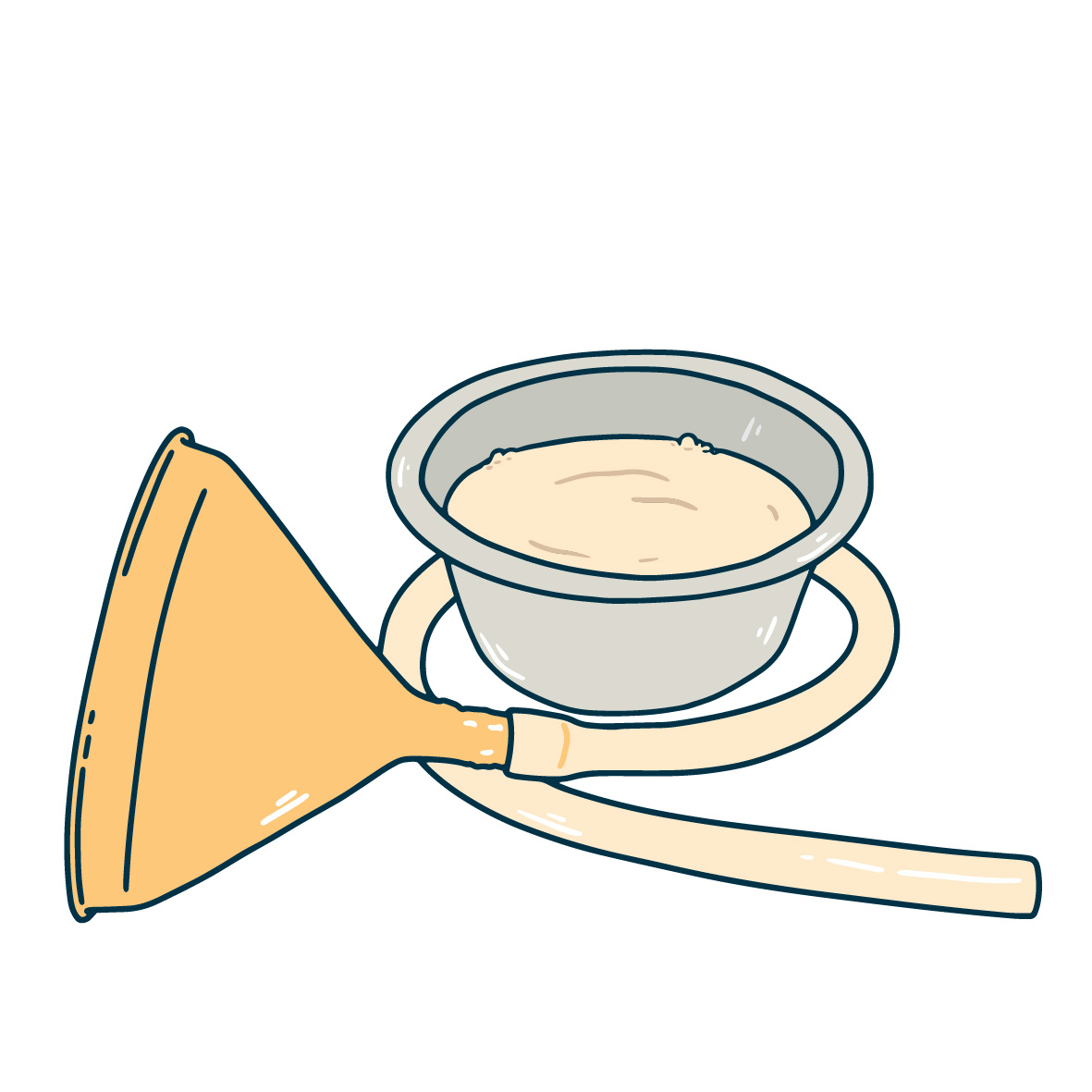Food and medicine
Wat een zeehond tijdens de opvang krijgt, wordt altijd bepaald door een dierenarts. Dit noemen we een behandelplan. Het geven van voeding en medicijnen wordt door een verzorger gedaan.

Food
A seal's diet is an important part of the healing process. The food that the seals receive from us resembles what they would eat in nature. We pay attention to:
- the amount of nutrients
- how often they eat
- how they eat
- how much fluid they ingest ze binnenkrijgen
Feeding list
The vets decide on the daily feeding for every seal. They create a list that states exactly what the seal gets during each feeding time. The nurses use these lists to prepare the food.
Fish porridge
At the beginning of their stay, we give the seals a kind of puree made from ground salmon. It contains many important fats, minerals and other nutrients. Severely weakened seals can digest the fish porridge a lot more easily than solid food. Fish porridge is mixed with water if the seals need extra fluid.
Did you know...
Seals' breast milk cannot be imitated? That is why we feed seal pups fish porridge.
To feed the fish porridge to the seals, we have to force-feed them. We insert a flexible, soft tube into the esophagus with a funnel at the end. We pour in the porridge there. This is a quick way to feed the seals. Speed is important in order to cause as little stress as possible for the animal.

Herring
When the seals switch to solid food, we always give them herring. Herring is a nutritious and firm fish, with a good shape for forcefeeding. By sticking to a single species of fish, we know how many nutrients the seals are getting per kilo of fish.
Our herring comes from Norway and is of high quality: in principle it is good enough for human consumption. We buy all the fish ourselves, it is not donated. This way we know that all fish is of good quality.
Frozen fish
The fish is dead when we give to the seals. The two main reasons for it:
- It is extremely expensive to keep enough live fish for seals. Sometimes we need hundreds of kilos a day!
- It is ethically irresponsible to give live animals to captive predators. There are rules in the Netherlands about which animals can and cannot be fed live to predators. Animals with a backbone (including fish) may only be used as food when they are dead.
The herring is already frozen when we get it. We keep it in a special freezer where only food for the seals is allowed. Freezing it keeps it fresh for longer and reduces the chance that it will still contain live parasites. Enough herring is thawed daily to feed that day, but it never stays longer than a day.
Learn to eat dead fish
You must be thinking: hunting should be easy! But seals are not used to eating dead fish because they hunt live animals in the wild. That is why they often have to learn to eat the dead herring themselves. This process usually involves three steps:
Forcefeeding – handfeeding – selfeating
Water
The seals that eat fish from the pool in the Sealcentre themselves do not need water. But the animals that receive less food do need a little extra fluid.
Did you know...
That a seal doesn't drink water? They get all the water they need from the fish they eat. It's a good thing: seawater is much too salty to drink!
As seals do not drink on their own, it is not possible to let them drink water from a bowl or bottle themselves. That's why we give it the same way as the fish porridge: forcefeeding with a tube and funnel.
Medicine
It is not a surprise that most seals at our rehabilitation centre need medication to get better. After the intake, the veterinarians decide what kind of medication the seal needs. During the seal's stay, it is constantly monitored whether the treatment plan needs to be adjusted. The vet also decides when the patient no longer needs medication.
Antibiotics
We only give the seals antibiotics if the vets determine they have a bacterial infection. The Dutch government has guidelines for the responsible use of antibiotics. If animals (and humans) use too many antibiotics, they can become resistant This means that the antibiotics will work less effectively and bacteria will not die.
Oral medication
Oral medications are medications that must be taken by the patient through the mouth in order to work. We always put these medicines in the seal's food. When they get fish porridge or water, we crush and mix the pills and add them through the funnel. Seals that are hand-fed or already eat themselves often get their pills in the fish.
These medicines can have a variety of effects. For example:
- Painkillers for animals with injuries
- Antibiotics against bacterial infections
- Deworming medication against lungworms
Local medication
Local medicines are applied to the place where they are supposed to work. Examples are:
- Mouth spray for wounds or inflammations in the mouth
- Ointment for skin ailments
- Eye drops
- Ear drops
Injections
Sometimes there are also medicines that need to be injected. This is then done by a vet, usually in the armpit of the seal.